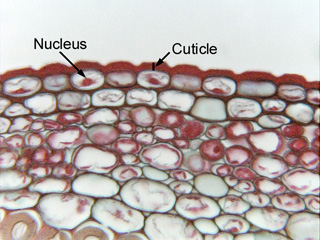Up
Ordinary epidermis
Guard cells
Thick cuticle
Thicker cuticle
Thin cuticle
Parasitic plant
Petal epidermis
Sclerified epidermis
Papillose epidermis
Sculptured cuticle
Elaborate cuticle
Cuticular horns
Radial walls
Cuticle proper
No epidermis
Epidermal peels
Cycad peel
Paradermal
Typical stoma
Sunken stoma
Stomatal orientation 1
Unusual orientation 2
Artifact
Stomata and fibers
Stomatal crypts
Crypts, mag.
Crypt margin
Non-crypt
Water lily
Stomatal channels
Groove, hi mag
Subsidiary cells
Ledges
Papillae
Trichome
Uniseriate hair
Peltate hair, mag
Peltate, lo mag
Branched hairs
Trichome base
Lithocyst, Ficus
Lithocysts, hemp
Bulliform cells
Grass epidermis
Multiple epi
Uniseriate?
Peperomia
| |
 Fig.
10.2-3.
Transverse section of spurge stem (Euphorbia corallata). The cuticle on this epidermis is unusually thick,
almost one-half the thickness of the lumen of the cell. Such thick cuticle
typically occurs only on plants of very dry habitats (where it is advantageous
in keeping water from evaporating from the plant) or of extremely wet ones
(where it prevents the abundant rainwater from leaching nutrients out of the
protoplasts). Notice that it is thinnest at the junctions between cells,
thickest over the cell body: the epidermis cells themselves bulge outward, but
the variation in cuticle thickness accentuates the roughness of the stem
surface. Fig.
10.2-3.
Transverse section of spurge stem (Euphorbia corallata). The cuticle on this epidermis is unusually thick,
almost one-half the thickness of the lumen of the cell. Such thick cuticle
typically occurs only on plants of very dry habitats (where it is advantageous
in keeping water from evaporating from the plant) or of extremely wet ones
(where it prevents the abundant rainwater from leaching nutrients out of the
protoplasts). Notice that it is thinnest at the junctions between cells,
thickest over the cell body: the epidermis cells themselves bulge outward, but
the variation in cuticle thickness accentuates the roughness of the stem
surface.
|
 Fig.
10.2-3.
Transverse section of spurge stem (Euphorbia corallata). The cuticle on this epidermis is unusually thick,
almost one-half the thickness of the lumen of the cell. Such thick cuticle
typically occurs only on plants of very dry habitats (where it is advantageous
in keeping water from evaporating from the plant) or of extremely wet ones
(where it prevents the abundant rainwater from leaching nutrients out of the
protoplasts). Notice that it is thinnest at the junctions between cells,
thickest over the cell body: the epidermis cells themselves bulge outward, but
the variation in cuticle thickness accentuates the roughness of the stem
surface.
Fig.
10.2-3.
Transverse section of spurge stem (Euphorbia corallata). The cuticle on this epidermis is unusually thick,
almost one-half the thickness of the lumen of the cell. Such thick cuticle
typically occurs only on plants of very dry habitats (where it is advantageous
in keeping water from evaporating from the plant) or of extremely wet ones
(where it prevents the abundant rainwater from leaching nutrients out of the
protoplasts). Notice that it is thinnest at the junctions between cells,
thickest over the cell body: the epidermis cells themselves bulge outward, but
the variation in cuticle thickness accentuates the roughness of the stem
surface.